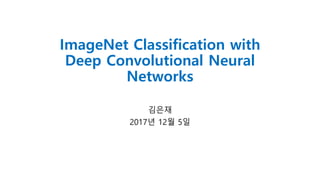
Image net classification with deep convolutional neural networks
- 1. ImageNet Classification with Deep Convolutional Neural Networks 김은재 2017년 12월 5일
- 2. 목차 Abstract Introduction The Dataset Reducing Overfitting Details of learning Results 1
- 3. Abstract 120만개 이미지를 분류하는 ImageNet LSVRC-2012 Contest에서 우리가 만든 모 델이 기존에 가장 좋은 성능을 보였던 모델보다 더 좋은 성능을 보임. Network Model • 60million parameter와 65,000 neurons를 가진 신경망은 5개의 convolutional layers와 max-pooling layers 그리고 3개의 fully-connected layers와 1000개의 softmax로 구성함. 훈련을 빠르게 시키기 위해 non-saturating neurons를 사용하고 더 효율적인 convolution 연산을 구현함. GPU Fully-connected layer에 overfitting을 줄이기 위해 dropout을 적용함. ILSVRC-2012 competition에서 error rate 15.3%를 기록하며 우승함. 2
- 4. 1. Introduction Objects recognition은 아직도 어려움을 많이 갖고 있음. Object recognition을 학습 시키기 위해서는 많은 수의 dataset이 더 필요한데 최 근에 많은 dataset(LabelMe, ImageNet 등)들이 등장함. CNN을 이용하여 Large dataset에 고화질 이미지를 적용하기에는 여전히 비용이 비싸지만 GPU가 좋아지고 Dataset들이 충분히 labeled 된 예들을 많이 갖고 있 어서 처리가 수월해짐. 이 논문의 기여 내용 • CNN을 이용하여 ImageNet Data를 훈련시켰고 최고의 결과를 보임. • 최적화 된 2D Convolution GPU 구현. • 훈련 시간을 줄이고 성능 개선을 위해 특별한 feature 사용. • Convolution Layer를 제거해보면서 depth의 중요성을 보임. 3
- 5. 2. The Dataset ImageNet • 22000 카테고리를 가진 15 million의 labeled images의 Dataset임. • 이미지는 Web에서 모아져 왔고 Amazon’s Mechanical Turk crowd-sourcing tool를 사용한 human labelers에 의해 labeled 되어짐. • 매년 ImageNet-Large-Scale Visual Recognition Challenge(ILSVRC)를 개최함. ILSVRC • 대략 1000개 카테고리마다 1000개의 이미지를 사용함. 1.2 million training images, 50,000 validation images, 150,000 testing images. • Error-rate를 측정하기 위해 top-1 그리고 top-5를 사용함. Top-1 : correct class와 모델에서 예측한 top class 같은가를 비교함. Top-5 : correct class와 모델에서 예측한 가장 높은 5가지 class 중에 같은게 있는가를 비교함. Our system • 256 * 256 down sampling • 이미지의 중앙의 256 * 256 cropping • 각 픽셀마다 이미지의 평균값으로 뺌. 4
- 6. 3. The Architecture (1) 3.1 ReLU Nonlinearity • 기존의 신경망 활성 함수로서 많이 사용되었던 tanh(x) or sigmoid(x) 함수는 트레이닝 시간이 올래 걸림. tanh(x) , sigmoid(x)가 트레이닝 시간이 긴 이유는 saturating nonlinearity 특성을 갖고 있기 때문임. • 이런 문제를 해결하기 위해 Rectified Linear Units(ReLUs)가 나옴.[Hinton] ReLU는 non-saturating nonlinearity (f(x) = max(0,x). • 오른쪽 그림은 error-rate가 25%가 될 때까지의 걸린 epochs를 보여준 그래프임. ReLU가 tanh보다 6배 더 빠르게 학습률을 달성함. 5
- 7. 3. The Architecture (2) 3.2 Training on Multiple GPUs • 1.2 million 이미지를 처리하기에는 GPU 하나로는 부족했음.(GTX580 메모리 3GB). • 커널의 절반을 나눠서 GPU 2개로 처리하였음. • GPU 1개보다 처리 시간이 덜 걸렸음. 3.3 Local Response Normalization • ReLU는 좋은 특징 중 하나는 input normalization이 필요로 하지 않음. • 그러나 Local Normalization은 Generalization을 올리기 위해 좋음. Normalization 적용 후 ReLU function 적용함. 식은 아래와 같음. N : 해당 레이어에 총 커널 수 i : 커널 인덱스 𝑎 𝑥,𝑦 𝑖 : i 커널에서의 x, y 위치의 값. K, 𝛼, 𝛽 Hyper-parameters : validation set을 통해 값을 찾음. 결과적으로 이것을 적용했을 때 error-rate가 top-1에서는 1.4% 그리고 top-5에서는 1.2% 줄일 수 있었음. CIFAR-10 dataset에서 CNN에 적용해본 결과 Normalization 없을 때는 13%, 있을 때는 11% Error-rate보임. 6
- 8. 3. The Architecture (3) 3.4 Overlapping Pooling • 필터 크기보다 보폭(stride)을 작게 만들어서 풀링을 하는게 error-rate를 더 낮출 수 있다고 함. top-1, top-5에서 각각 0.4%, 0.3% 줄임. 3.5 Overall Architecture • 총 8개의 Layer로 구성함. 7
- 9. 3. The Architecture (4) • 5개의 Convolutional과 3개의 Fully connected layers로 구성됨. • 1000 class를 분류하기 위한 Softmax가 마지막에 output으로 있음. • 2, 4, 5 layer는 각각 나눠진 GPU 처리 결과를 나눠서 처리함. 과정 • 1 layer에서 224*244*3 input image를 96 kernals 11*11*3 filtering함.(stride 4) • Response-normalized(1,2 layer에서만)와 ReLU, pooling 작업을 함. • 2 layer에서 256 kernals 5*5*48로 filtering 후 위와 동일한 과정 거침. (stride 2) • 3,4,5 layer는 pooling과 normalization 과정 없이 conv 처리하고 fully connected layer를 거쳐서 softmax를 통해 분류를 하게 됨. 8
- 10. 4. Reducing Overfitting 4.1 Data Augmentation • Label-preserving transformation Translation, Horizontal reflection • Altering the intensities of the RGB channels Training image에 PCA 적용함. + - P : 공분산 행렬의 i번째 고유벡터, 𝜆 : i번째 공유치, 𝛼 : 랜덤한 가중치 4.2 Drop out • Hidden Layer에서 랜덤하게 몇 개의 Neuron들만 사용하여 학습시키는 방법임. 이 논문에서는 50%의 Neuron만 사용함. 50% Neuron들은 Output값을 0으로 만듦. • Drop out된 Neuron들은 forward pass하거나 backpropagation을 하지 않음. • 네트워크가 컸을 때 훈련시키는 시간을 단축시킬 수 있음. • Drop out을 사용하지 않았을 경우 상당한 overfitting이 발생함. 9
- 11. 5. Details of learning Stochastic gradient descent(SGD)를 사용함. • Batch size 128 momentum 0.9, weight decay 0.0005 • 작은 Weight decay 값이 모델의 training error를 줄여줌. Update rule for weight w Weight들은 zero-mean Gaussian distribution를 사용하여 초기화함. • 표준편차 0.01 2,4,5 Layer와 Fully-connected layer에서 bias는 1로 초기화 나머지는 0으로 초기 화함. Learning rate는 0.01로 초기화함. 1.2 million images를 90번 훈련시켰고 5~6일 걸림. 10
- 12. 6. Results (1) ILSVRC-2010 결과 ILSVRC-2012 결과 11
- 13. 6. Results (2) Qualitative Evaluations • Figure3 위에 3줄은 GPU1에서의 kernal 아래 3줄은 GPU2에서의 kernal임. GPU1에서의 kernal은 color-agnostic하고 GPU2에서의 kernal은 color-specific함. • Figure4 왼쪽은 8개의 이미지에서 예측값이 가장 높은 5개 Label을 보여주고 있음. - mite 중앙과 멈에도 인지함. - Grille, cherry 애매함. 오른쪽은 첫번째 열은 test image이고 나머지는 test image와 유사한 training image임. - Feature vector들 사이에 유클리디안 거리가 가까운거. - 훈련 시에 auto-encode를 쓰면 더 효율적임. 12
- 14. 7. Discussion 우리의 모델이 이전에 가장 좋았던 성능의 모델 기록을 깸. 우리 모델에서 중간 레이어를 제거하면 성능이 2% 떨어지는 것을 확인함(top-1 기준). 즉, 모델의 깊이는 중요함. 궁극적으로 우리는 비디오 시퀀스에서 매우 크고 깊은 convolutional nets 을 사용하길 원함. 13
- 15. Thank you 14